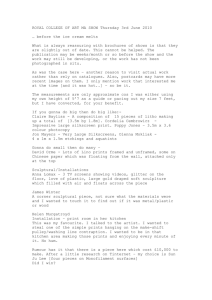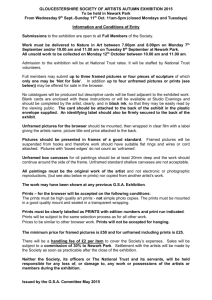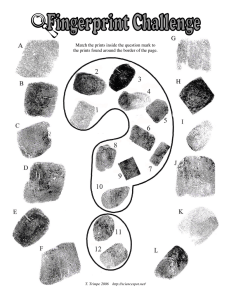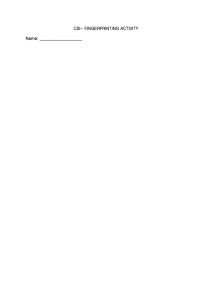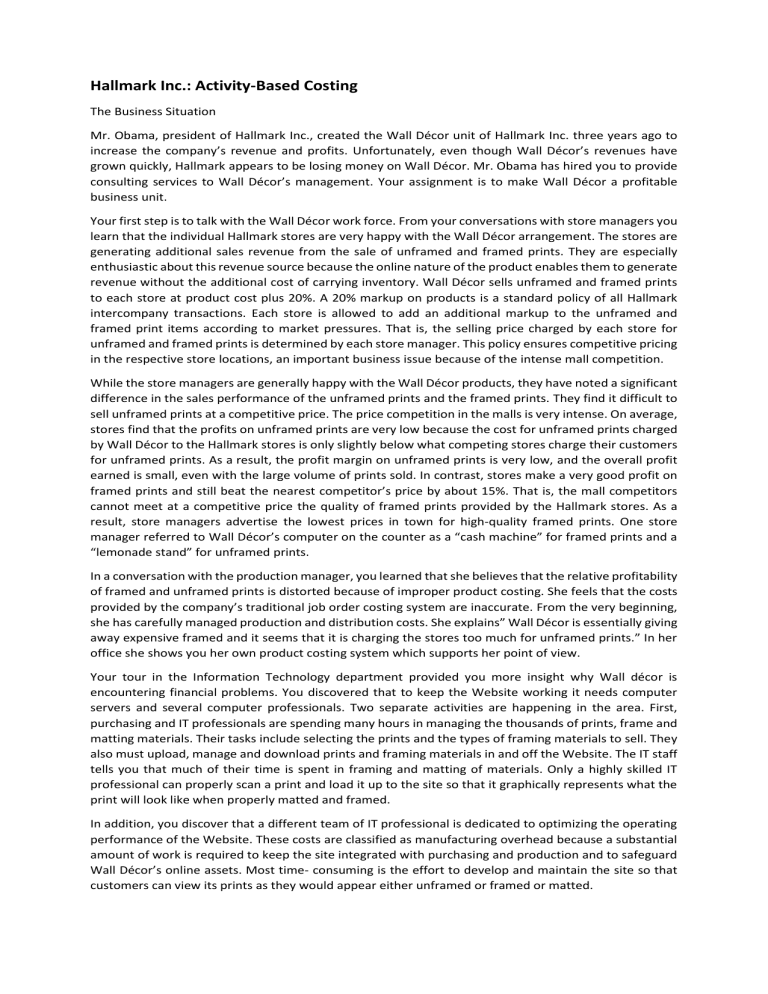
Hallmark Inc.: Activity-Based Costing The Business Situation Mr. Obama, president of Hallmark Inc., created the Wall Décor unit of Hallmark Inc. three years ago to increase the company’s revenue and profits. Unfortunately, even though Wall Décor’s revenues have grown quickly, Hallmark appears to be losing money on Wall Décor. Mr. Obama has hired you to provide consulting services to Wall Décor’s management. Your assignment is to make Wall Décor a profitable business unit. Your first step is to talk with the Wall Décor work force. From your conversations with store managers you learn that the individual Hallmark stores are very happy with the Wall Décor arrangement. The stores are generating additional sales revenue from the sale of unframed and framed prints. They are especially enthusiastic about this revenue source because the online nature of the product enables them to generate revenue without the additional cost of carrying inventory. Wall Décor sells unframed and framed prints to each store at product cost plus 20%. A 20% markup on products is a standard policy of all Hallmark intercompany transactions. Each store is allowed to add an additional markup to the unframed and framed print items according to market pressures. That is, the selling price charged by each store for unframed and framed prints is determined by each store manager. This policy ensures competitive pricing in the respective store locations, an important business issue because of the intense mall competition. While the store managers are generally happy with the Wall Décor products, they have noted a significant difference in the sales performance of the unframed prints and the framed prints. They find it difficult to sell unframed prints at a competitive price. The price competition in the malls is very intense. On average, stores find that the profits on unframed prints are very low because the cost for unframed prints charged by Wall Décor to the Hallmark stores is only slightly below what competing stores charge their customers for unframed prints. As a result, the profit margin on unframed prints is very low, and the overall profit earned is small, even with the large volume of prints sold. In contrast, stores make a very good profit on framed prints and still beat the nearest competitor’s price by about 15%. That is, the mall competitors cannot meet at a competitive price the quality of framed prints provided by the Hallmark stores. As a result, store managers advertise the lowest prices in town for high-quality framed prints. One store manager referred to Wall Décor’s computer on the counter as a “cash machine” for framed prints and a “lemonade stand” for unframed prints. In a conversation with the production manager, you learned that she believes that the relative profitability of framed and unframed prints is distorted because of improper product costing. She feels that the costs provided by the company’s traditional job order costing system are inaccurate. From the very beginning, she has carefully managed production and distribution costs. She explains” Wall Décor is essentially giving away expensive framed and it seems that it is charging the stores too much for unframed prints.” In her office she shows you her own product costing system which supports her point of view. Your tour in the Information Technology department provided you more insight why Wall décor is encountering financial problems. You discovered that to keep the Website working it needs computer servers and several computer professionals. Two separate activities are happening in the area. First, purchasing and IT professionals are spending many hours in managing the thousands of prints, frame and matting materials. Their tasks include selecting the prints and the types of framing materials to sell. They also must upload, manage and download prints and framing materials in and off the Website. The IT staff tells you that much of their time is spent in framing and matting of materials. Only a highly skilled IT professional can properly scan a print and load it up to the site so that it graphically represents what the print will look like when properly matted and framed. In addition, you discover that a different team of IT professional is dedicated to optimizing the operating performance of the Website. These costs are classified as manufacturing overhead because a substantial amount of work is required to keep the site integrated with purchasing and production and to safeguard Wall Décor’s online assets. Most time- consuming is the effort to develop and maintain the site so that customers can view its prints as they would appear either unframed or framed or matted. A discussion with IT professional suggests that the time spent on developing and maintaining the site for the unframed prints is considerably less than the required for the framed prints and in particular for the framed and matted prints. Developing and maintain a site for the unframed prints is relatively straight forward. It becomes more complicated when the site must allow the customer to view every possible combination of print with every type of steel frame, and immensely more complicated when one considers all the possible wood frames and different matting colors. More time of IT professionals ate needed to present the over 1,000 different framing and matting options. Based on your preliminary findings, you have decided that the company’s ability to measure and evaluate the profitability of individual products would be improved if the company employed an ACTIVITY BASED COSTING system. As a first step in this effort, you compiled a list of cost, activities and values. Your work consisted of taking the manufacturing overhead cost of P375,200.00 and allocating the cost to activities presented on schedules shown below DIFFERENT ACTIVITIES OF THE COMPANY ACTIVITY COST DRIVER ESTIMATED OVERHEAD EXPECTED USE OF COST DRIVER 1 Picking prints Number of prints 30,600.00 2 Inventory, selection and management No. of component per print Print -1 Print/ frame- 2 Print/mat/frame 3 91,700.00 No. of prints cap. No. of prints cap. total 25,800.00 103,200.00 129,000.00 Unframed prints: 100,000 print capacity Framed and/or matted prints: 25,000 prints (16,000 steel and 9,000 wood) No. of component at capacity 123,900.00 Print/frame (16000 x 2) = 32,000 comps. Print/Mat/Frame ( 9000x3) = 27,000 comps total = 59,000 components at capacity 3 4 Website Optimization Unframed Framed Framing and Matting Cost ( equipment, insurance, rent and supervisory labor) Unframed= 80,000 prints Steel Framed = 15,000 prints Wood Framed= 7,000 prints Total = 102,000 prints Print: 80000 components Print/frame (15000x2)= 30,000 components Print/mat/frame (7000x3)= 21,000 comp. TOTAL= 131,000 components In the Website Optimization activity, the total overhead cost is expected to be 129,000. It was difficult to identify the cost driver that directly related to Website optimization to the products. In order to reflect that the majority of the time spent related to the framed prints, the cost of the Website optimization must be split to unframed prints and framed prints. Based on the discussion with the IT professionals, you determined that they spent roughly 1/5 of their time is associated with the unframed prints and the remaining time is for the framed prints even though the number of framed prints sold is substantially less than the number of the unframed prints. As a consequence, the cost associated with the Website Optimization is allocated at P25,800 for unframed prints and P103,200 for framed prints. You contemplated having three categories (unframed, Steel framed and wood framed with matting), but chose not to add this additional refinement. Once the P129,000 of the Website Optimization was allocated across the two broad product categories, the number of prints at operating capacity was used as the cost driver. Note that the operating capacity was used instead of the expected units because the employees are salaried. If a fixed cost is allocated using a value that varies from period to period (like expected sales), then the cost per unit a base that does not vary as much, such as the operating capacity. The advantage of using the operating capacity as the base is that it keeps the fixed cost per unit stable over time. The same reason was adopted in the final activity wherein you chose to base the cost driver on levels of operating capacity, rather than at expected sales level. The above transactions are further summarized in a schedule below TOTAL OVERHEAD COSTS AND COST DRIVERS USED PER PRODUCT Activity 1 Picking prints 2 Inventory, select. & mgt. 3 Website Cost Driver Number of prints No. of component No. of prints cap. 4 Framing and Matting at capacity Wood framed No matting with matting TOTAL Overhead Cost 80,000.00 15,000.00 7,000.00 102,000.00 30,600.00 80,000.00 30,000.00 21,000.00 131,000.00 91,700.00 100,000.00 25,800.00 100,000.00 Optimization No. of component Steel framed Unframed NA 16,000.00 9,000.00 25,000.00 103,200.00 32,000.00 27,000.00 59,000.00 123,900.00 TOTAL 375,200.00 Instructions: Answer the following questions 1. Identify two reasons why an activity based costing system may be appropriate for Wall décor. 2. Compute the activity based overhead rates for each of the 4 activities 3. Using the data below (based on Predetermined manufacturing overhead rate of .28 computed in the old and traditional costing method) and the above activity based overhead rates, compute the product cost of the unframed print, steel framed no matting and wood framed with matting. Print Direct material Print Frame and glass Matting Direct labor Picking Matting and framing Manufacturing overhead (0.28 X $12, $16, $20) Total product cost Steel-Framed Print, No Matting Wood-Framed Print, with Matting $12.00 $16.00 4.00 $20.00 6.00 4.00 2.00 2.00 7.00 2.00 10.50 4.48 $33.48 5.60 $48.10 3.36 $17.36 4. Compare the product cost computed under the traditional costing system and activity based costing system. Analyze and evaluate the differences and cite the potential implication to the company. 5. Explain why overhead cost related to Website Optimization was first divided on to categories (unframed prints and framed prints) and then allocated based on the number of prints. 6. When allocating the cost of the Website optimization, the decision was made initially allocate the cost across two categories (unframed prints and framed prints) rather than three categories (unframed prints, steel framed no matting and wood framed with matting). Discuss the pros and cons of splitting the cost between two categories rather than three categories. 7. Discuss the implications of using the operating capacity as the cost driver rather than the expected units sold when allocating fixed overhead costs. 8. (a) Allocate the overhead to the three product categories (unframed prints, steel framed no matting and wood framed with matting), assuming that the estimate of the expected units sold is correct and the actual amount of overhead incurred equaled the estimated amount of P375,200. (b) calculate the total amount of the overhead allocated. Explain why the total overhead of P375,200 was not allocated, even though the estimate of sales was correct. What are the implication of this for management?

